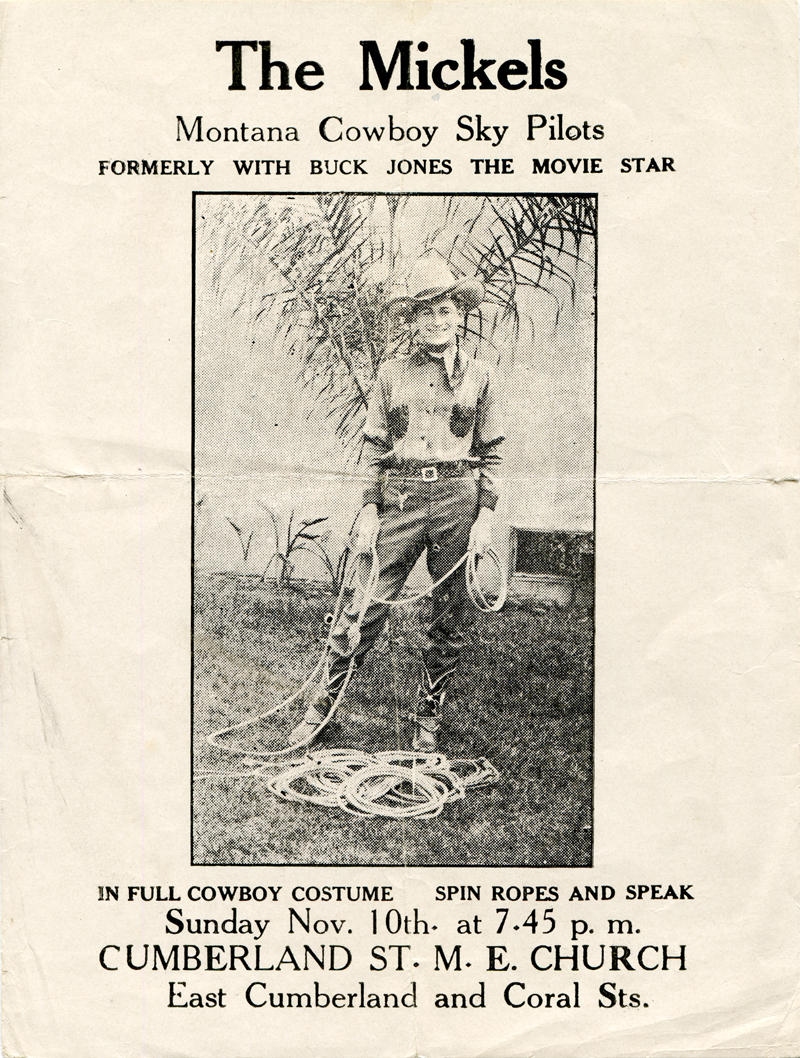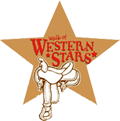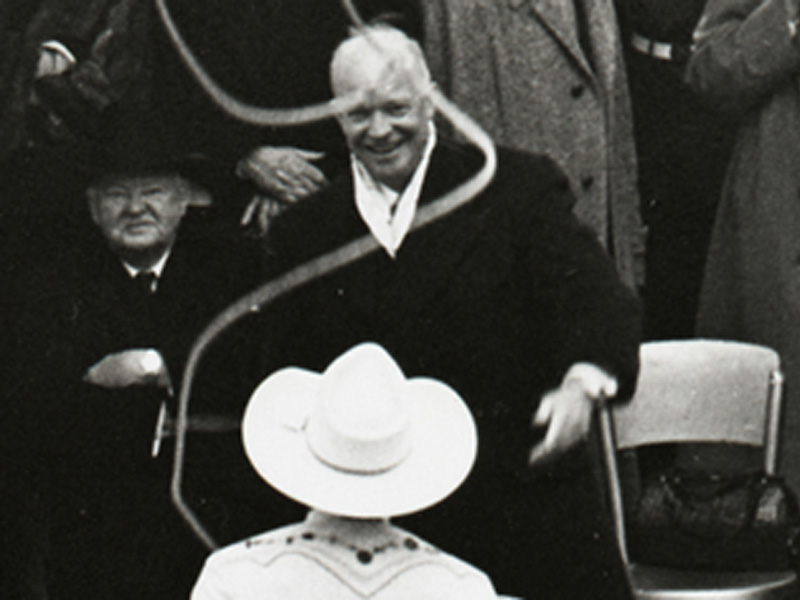|
|
Montie Montana & Parents

Click image to enlarge November 10, 1929 — Handbill promoting an appearance by E.O. Mickel and family at the Cumberland Street Methodist Episcopalian Church in Philadelphia. 6x8 inches, one-sided. The young man in the picture is Montie Montana, the world-famous trick roper who moved to Agua Dulce in 1976 and lived there for the last 22 years of his life (except for a brief stay in Palm Springs, which didn't suit him). Montie started life as Owen Harlan Mickel on June 10, 1910, in North Dakota (not Wolf Point, Mont., as often reported). He was born to a pair of traveling Western entertainers — Edgar Owen Mickel and Mary Edna Harlan Mickel, who had a popular whip act. Montie quickly learned to trick-rope. Edgar was also an adept orator who knew how to preach the gospel, and he had a magic lantern and a collection of slides. He'd use one or more of these talents depending on the audience. Montie writes: "Dad was such a happy, enthusiastic man, and everyone liked him. E.O. Mickel just never met a stranger. He would give a talk at churches, schools or club houses, and show his slides of cowboys, Indians and Yellowstone Park. This went over real well because the people just didn't travel or get to see much in those days. I would trick rope and we made enough to keep traveling around the country" (Montana 1993:25). To roust up an audience as the family traveled from town to town before and during the Great Depression, Montie and his parents would distribute handbills. This one reads: The Mickels / Montana Cowboy Sky Pilots / Formerly with Buck Jones the movie star / In full cowboy costume / Spin ropes and speak. A "sky pilot" is a horseback preacher. The date and the city aren't shown. We know it's Philadelphia because that's where there is a Cumberland Street Methodist Episcopalian Church at East Cumberland and Coral streets. Here's how we know it's 1929... The Mickels performed with Buck Jones' Wild West Show until the first part of 1929. In fact, that's where Montie got his stage name. He'd always called himself Montie — he didn't like his given name — and one day Jones' announcer forgot his surname and called him "Montie, the Montana Kid." It stuck. Since we know they were "formerly" with Buck Jones, we know it's no earlier than 1929. In his autobiography, Montie includes pages of log books in which he kept a record of their performance venues. The last four months of 1929 and the last three months of 1930 aren't shown. The years 1931 and 1932 show the family remained in the L.A. area. In fact, they performed at Hoot Gibson's Saugus rodeo in the springtime and at other rodeos in which Gibson and promoter Bob Anderson were involved throughout the year, all in the Southland. In 1933, Montie got married (Buck Jones was his best man) and he didn't leave the West Coast. He also went his own way at this time, leaving his parents behind as he performed with bigger and bigger shows, circuses and rodeos. That leaves either 1929 or 1930, and November 10 was a Sunday in 1929. It was a Monday in 1930. So it's 1929.
About Montie Montana
Born Owen H. Mickel, Montie (June 10, 1910 - May 20, 1998) traveled with his dad, E.O. [Edgar Owen] Mickel, and mother [Mary Edna Harlan Mickel]. Billed as the Montana Cowboys, they did whip and rope acts and put on a slide show about the American West. In 1929 while working the Buck Jones Wild West Show, the announcer could not remember his name, so he announced him as Montie from Montana, and as Montie tells us in his autobiography, "the crowd loved it and so did I." From then on he became known as Montie Montana. As a star of silver screen, stage and rodeo arena, Montie entertained audiences around the world for more than 70 years. He rode in 60 consecutive Rose Parades and is famous for roping President Eisenhower in the 1953 Inaugural Parade. From 1945 to 1965 Montie thrilled over 8 million school children with his stagecoach and horse, Rex. Montie was famous for riding his horses into equally famous places such as the top of the Empire State Building, the Beverly Wilshire hotel in Beverly Hills, the Brown Palace in Denver, the Broadmoor in Colorado Springs and top-level government offices across the country. Though he received hundreds of awards and honors during his extraordinary lifetime, he remained a cowboy at heart. Montie was deeply grateful that he could make a living doing what he loved best — and it showed. He had the most wonderful laugh and was always smiling. An avid collector of Western artifacts, he kept treasures from early on in his career and enjoyed them throughout his life. His legacy will live on with the stories captured in this autobiography where he tells us that he lived in a great era, from the horse and buggy to the space age. Although he has ridden on ahead, I know that he's in tall cotton with other great Western heroes up there and that his horses are knee deep in green pastures and that he's still a cowboy, because he always said, "I must have been born a cowboy because I've never thought of being anything else." Further reading: Read more about Montie Montana here.
LW2559: 19200 dpi jpeg from original handbill purchased 2013 by Leon Worden. |
SCVTV Interview ~1995
First Touring Wagon 1925
Pendleton 1927 Rope
Handbill 1929
With Jerry Colonna ~1940s
Roping Ike 1953
Jumps Through Rope 1950s
Roping in Portland 1955
1965 Rose Parade
Work Hat 1964/65
1970 Rose Parade
Driving Wagon ~1972
Wolf Point So-called Dollar 1975
Benefit Powwow 1978
Events 1970s-80s
Montie & Marilee w/ Art Brewer, Agua Dulce 1990s
Agua Dulce x2
|
The site owner makes no assertions as to ownership of any original copyrights to digitized images. However, these images are intended for Personal or Research use only. Any other kind of use, including but not limited to commercial or scholarly publication in any medium or format, public exhibition, or use online or in a web site, may be subject to additional restrictions including but not limited to the copyrights held by parties other than the site owner. USERS ARE SOLELY RESPONSIBLE for determining the existence of such rights and for obtaining any permissions and/or paying associated fees necessary for the proposed use.

















